Connor Bahr can’t resist guacamole.
“We put it on his tray and he just scoops it right up,” his mom, Marci, said. “He’s a mess, but he loves it.”
It’s absolutely worth the mess to see him eating well and gaining weight, because a few months ago he was doing neither.
At 8 months old, Connor stopped gaining weight.
Like many infants who have Down syndrome—a chromosomal abnormality that causes developmental disabilities—Connor has low muscle tone, including weak oral muscles.
He was nursing exclusively and wasn’t getting enough calories for sustained growth.
His parents tried supplementing his feedings with formula from a bottle, but Connor would have nothing to do with it. They spoonfed him pureed foods, and though he seemed to like the flavors, he would reflexively push the foods out with his tongue rather than swallow.
“He just didn’t really know what to do with them,” Marci said. His lips, tongue, cheeks and jaw seemed uncoordinated, not ready to deal with age-appropriate solids.
Concerned about Connor’s weight, the Bahrs, residents of Hudsonville, Michigan, took their pediatrician’s advice and signed him up for feeding therapy with Meghan Vandewater, CCC-SLP, a speech and language pathologist at the Spectrum Health Zeeland Community Hospital outpatient rehabilitation center.
Mouth muscle training
Vandewater started Connor on an oral motor program to strengthen and train the muscles of his mouth and face, bringing them into coordination. Her work always involved two steps: exercises to prepare Connor’s mouth, followed immediately by the activity of eating or drinking.
The exercises create oral awareness and activate the muscles. Vandewater would start by stroking Connor’s cheeks, jaw and chin from back to front, stimulating his face muscles and drawing attention to his mouth.
With gloved hands, she would then massage his gums and stimulate the inside of his mouth, activating the muscles of his cheeks, tongue, palate and jaw.
After each muscle group, she would touch Connor under his chin to prompt him to swallow.
“You get the muscles ready to do what you want them to do, and then you follow with the function—the (eating or) drinking,” Vandewater said.
Gradually, Connor figured out how to get his tongue to work together with his other chewing and swallowing muscles. Between weekly sessions with Vandewater and the exercises Marci did with him at home, he learned to eat purees from a spoon. Then he progressed to solids.
“He really was excited about eating with his hands and eating the same food that the family was eating,” said Marci, who also has a 6-year-old daughter and a 4-year-old son. Vandewater helped her introduce table foods safely.
All the while, Marci and her husband watched his weight climb—slowly at first and then with more speed.
“The last couple months it was just exciting to get him weighed,” she said. “It was good, substantial weight.”
Building drinking skills
Once Connor conquered solid foods, Vandewater shifted the focus to his drinking skills. Though he was still getting fluids by nursing, Connor needed to learn to drink from other sources.
At nearly a year old, he could skip bottles and go straight to a sippy cup. To teach him, Vandewater stuck to her two-step approach: preparation, then function. She used a vibrating oral probe to wake up his mouth and teach lip rounding; then she trained him to elevate his tongue so he could draw the liquid in.
Today, Marci said, Connor is comfortable with drinking from a sippy cup.
“I feel like when we’re ready to discontinue nursing that he’ll be equipped to drink on his own,” she said. “And Meghan made it really fun for him.”
In October, just six months after his first appointment, Connor graduated from feeding therapy. His mom is thrilled, both with his progress and with the therapy experience.
“Meghan educated us, and she empowered us to make decisions that would help him,” Marci said.
“His weight is back up on the growth curve, and I could not be happier with how he’s gaining.”
Connor continues to do outpatient physical therapy to develop his core, which supports his success in feeding, and to build strength in his arms and legs.




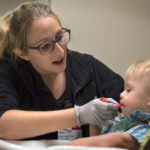
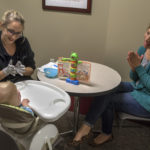
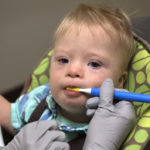
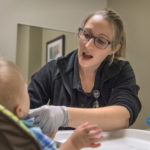




 /a>
/a>
 /a>
/a>
 /a>
/a>